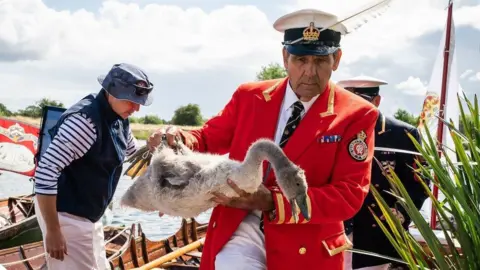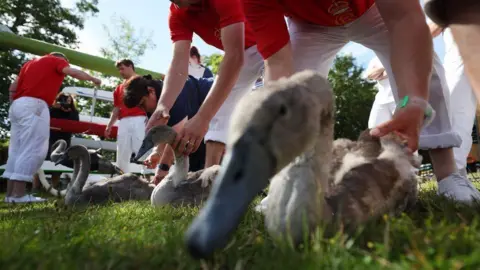Why do we count swans on the River Thames every year?
 PA Media
PA MediaAn annual medieval tradition of counting swans on the River Thames is returning.
Swan upping is a royal census of the birds on the river, dating back to the 12th Century, which aims to give an insight into their population.
It comes after only 86 young swans were found in 2024, a 45% decline in two years.
The count is carried out every July by a crew of swan uppers who are dressed in a traditional scarlet uniform and travel along the river in rowing boats counting for five days.
The count will start later at Sunbury Lock in Middlesex, and finish at Abingdon Bridge, Oxfordshire, on Friday 18 July.
During the count the King's Swan Marker is tasked with tracking the number of young cygnets to ensure the swan population is maintained.
As part of the event, cygnets are weighed and measured to check growth rates and check young and adult swans for any sign of disease or injury.
The swan marker will then produce an annual report with the results.
'Seen a downturn'
This year's swan marker, David Barber, said: "Cygnet numbers in the last two years have seen a downturn, primarily due to the outbreaks of Avian Influenza suffered by the bird population across the United Kingdom.
"Fortunately, there has been a decrease in reported cases of the disease in the River Thames area in recent months.
"Calmer river conditions of recent weeks will also benefit young cygnets as they learn to navigate the waterways with their parents."
What is swan upping?
Swan upping dates back to when the crown claimed ownership of "all mute swans", which were considered an important food for banquets and feasts.
The birds are no longer eaten and are now a protected species, however, the crown retains the right of ownership.
The King mainly exercises this right on stretches of the River Thames and ownership is shared with the Vintners' and Dyers' Livery Companies, who were granted rights of ownership by the crown in the 15th Century.
The cygnets are ringed with a unique British Trust for Ornithology identification number for scientific purposes during the swan upping.
 Reuters
ReutersChildren from local primary schools along the route have been invited to watch the swan upping and ask questions.
Mr Barber said: "The children's enthusiasm to demonstrate their knowledge of swans and their habitats is very rewarding, and it's always a joy to have them join us along the route.
"They are also, of course, fascinated by the royal connection with swans and have lots of interesting questions to ask."
You can follow BBC Berkshire on Facebook, X (Twitter), or Instagram.
